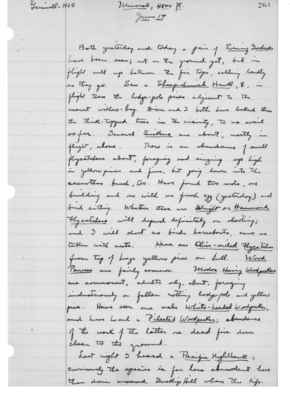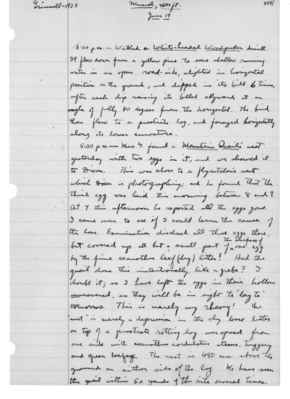Pages That Mention Flycatcher
1925: Joseph Grinnell's field notes
S2 Page 7
Collector: Grinnell - 1925 Location: Lassen Section (Mineral) Date: June 14, 1925 Page Number: 2463
Both yesterday and today a pair of Evening Grosbeaks have been seen; not on the ground yet, but in flight well up between the fir tops, calling loudly as they go. Saw a Sharp-shinned Hawk, female, in flight thru the lodge-pole pines adjacent to the nearest willow-bog. Dixon and I both have looked thru the thick-topped trees in the vicinity, to no avail so far. Several Siskins are about, mostly in flight, above. There is an abundance of small flycatchers about, foraging and singing up high in yellow pines and firs, but going down into the ceanothus bush, too. Have found two nests, one building and one with one fresh egg (yesterday) and bird sitting. Whether these are Wright or Hammond Flycatchers will depend definitely on shooting; and I will shoot no birds hereabouts, save any (?) taken with nests. Hear one Olive-sided Flycatcher from top of huge yellow pine on hill. Wood Pewees are fairly common. Modoc Hairy Woodpeckers are commonest, adults only, about, foraging industriously on fallen rotting lodge-pole and yellow pine. Have seen one male White-headed Woodpecker, and have heard a Pileated Woodpecker; abundance of the work of the latter on dead firs down clean to the ground. Last night I heard a Pacific Nighthawk; curiously this species is far less abundant here than down around Inskip Hill where the life-
S2 Page 26
Collector: Grinnell-1925 Location: Mineral, 4800 ft. Date: June 19 Page Number: 2481
3:00 p.m. - Watched a White-headed Woodpecker drink. It flew down from a yellow pine to some shallow running water in an open road-side, alighted in horizontal position on the ground, and dipped it's bill 6 times, after each dip raising its billed skyward at an angle of fully 80 degrees from the horizontal. The bird then flew to a prostrate log, and foraged horizontally along its lower curvature.
5:00 p.m. - Mrs. G found a Mountain Quail's nest yesterday with two eggs in it, and we showed it to Dixon. This was close to a flycatcher's nest which Dixon is photographing; and he found that the third egg was laid this morning between 8 and 9. At 4 this afternoon he reported all the eggs gone. I came over to see if I could learn the cause of the loss. Examination disclosed all three eggs there, but covered up all but a small part of the surface of one egg, by the fine ceanothus leaf (dry) litter! Had the quail done this intentionally, like a grebe? I doubt it; so I have left the eggs in their hollow uncovered, so they will be in sight to "lay to" tomorrow. This is merely my theory! The "nest" is merely a depression in the dry loose litter on top of a prostrate rotting log, overspread from one side with ceanothus cordulatus stems, twiggery and green leafage. The nest is 480 mm. above the ground on either side of the log. We have seen the quail within 50 yards of the site several times.

